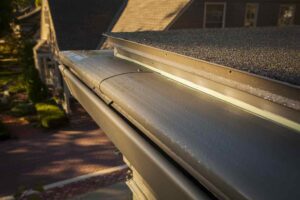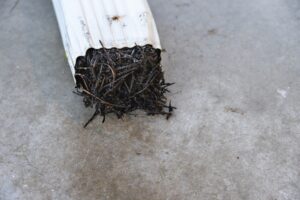
Gutters are an often overlooked but vital part of your home’s defense system. They channel rainwater away from your roof and foundation, protecting your home from water damage. However, like any other part of your home, gutters can wear out over time and may eventually need to be replaced. But how do you know when it’s time to take that step? This guide will walk you through the key signs that your gutters might need replacing and why it’s crucial to act promptly.
Check the Width of Your Gutters
One of the first things to assess when evaluating your gutters is their width. Step outside and take a close look at the end of one of your gutter runs. Focus on the end cap—the piece that seals off the gutter. Standard gutters are typically 5 inches wide, which is sufficient for handling most rainfall. However, if your gutters are only 4 inches wide, it’s a clear sign that they need to be replaced.
Why does this matter? Four-inch gutters are an outdated technology. They were designed for a time when homes were built with smaller roofs and less consideration for extreme weather conditions. Today, they simply can’t keep up with the volume of water that modern homes have to deal with during a storm. These narrower gutters struggle to drain water efficiently, leading to overflow. When water overflows from the front of the gutter, it cascades down your exterior walls and pools around your foundation. This can result in basement flooding and, over time, cause your foundation to settle unevenly or even crack. Foundation repairs can be incredibly expensive, often running upwards of $40,000—a cost that far exceeds the price of installing new, properly sized gutters.
Water overflowing from the back of the gutter can be equally damaging. It often seeps into the fascia board—the wooden board that runs along the edge of your roof and to which the gutters are attached. As this wood becomes saturated, it starts to rot and soften. When your gutters are attached to softwood, they become less secure and more prone to detachment, especially under the weight of ice and snow during winter. This can lead to further damage, as gutters that pull away from your home leave gaps where water can seep in, causing even more extensive damage to your roof and walls.
Inspect for Water Damage
As you examine your gutters, look for visible signs of water damage around your home. Water damage is a clear indication that your gutters are not performing their job effectively. Start by inspecting the fascia board behind the gutters. If you notice any discoloration, rotting, or sagging, it’s a strong indicator that water is getting behind your gutters and not being properly directed away from your home.
Another area to check is the soffit—the underside of the roof overhang. If the soffit is sagging or shows signs of water damage, this could mean that water has been leaking into areas it shouldn’t be. When water infiltrates your home’s structure, it can lead to mold growth, particularly black mold, which thrives in dark, damp environments like the space behind your drywall. Mold isn’t just a structural concern; it’s also a health hazard, especially for those with allergies or respiratory conditions.
Exterior walls are also at risk when gutters aren’t functioning properly. Look for water stains on your siding or paint. Water that runs down the sides of your home can cause the paint to peel, the siding to warp, and in some cases, it can even lead to wood rot in the framing of your house. These issues can be costly to repair and can significantly impact the aesthetic and market value of your home.
Look for Bowing or Bending
Structural integrity is another critical aspect to consider when assessing your gutters. After examining for water damage, take a step back and look down the length of your gutter run. Focus on the outer lip of the gutter. Is it completely straight, or do you notice any bowing or bending?
Bowing or bending often occurs in regions with extreme temperature fluctuations, such as Colorado, where temperatures can shift dramatically within a single day. During the winter, these rapid temperature changes cause the snow and ice in your gutters to repeatedly freeze and thaw. When ice forms, it expands—think of the way an ice cube cracks when you drop it into a glass of water. This expansion can cause the aluminum of your gutters to bow outward between the brackets that secure them to the fascia.
As the ice expands and contracts, it puts stress on the brackets, pulling them away from the fascia and potentially loosening the screws that hold everything in place. Once this happens, the gutters can start to detach from your home, leading to gaps where water can enter and cause further damage. If you notice any bowing or bending, it’s a tell-tale sign that your gutters have been compromised and should be replaced before they cause more extensive and costly damage.
Evaluate the Gutter Material and Age
While inspecting the width, water damage, and structural integrity of your gutters, it’s also important to consider the material and age of the gutters themselves. Different materials have different lifespans. For instance, aluminum gutters are popular due to their affordability and resistance to rust, but they typically last around 20 years. Copper gutters, on the other hand, can last up to 50 years but come with a much higher price tag.
If your gutters are approaching the end of their expected lifespan, it might be time to consider replacing them, even if they don’t yet show obvious signs of failure. Older gutters are more prone to problems like leaks, rust, and detachment, all of which can lead to significant damage to your home if not addressed promptly.
Consider Upgrading to a Gutter Protection System
If you’re already considering replacing your gutters, it might be worth looking into upgrading to a gutter protection system. These systems are designed to keep debris out of your gutters, reducing the need for regular cleaning and maintenance. By preventing clogs, gutter protection systems help ensure that water can flow freely through your gutters and downspouts, reducing the risk of overflow and the associated damage to your home.
There are several types of gutter protection systems available, ranging from mesh screens to surface tension systems that allow water to flow into the gutter while keeping leaves and debris out. While these systems can be an additional upfront cost, they can save you money in the long run by extending the life of your gutters and reducing the need for costly repairs.
Protect Your Home by Replacing Faulty Gutters with K-Guard
Regular gutter inspections are essential to prevent costly water damage and maintain your home’s structural integrity. By keeping an eye out for these signs—narrow gutters, water damage, bowing, and considering the material and age—you can determine when it’s time to replace your gutters. Upgrading to a modern gutter system or adding gutter protection can further safeguard your home from the elements.
If you’re unsure about the condition of your gutters or need professional advice, please contact K-Guard Rocky Mountains for a free inspection. If your gutters do need to be replaced we can replace them with new ones with patented internal brackets and a double lifetime transferable warranty guaranteeing that they will never need to be cleaned or replaced due to back pitching or pulling away, it simply won’t happen. If it does, we will come and repair or replace your gutters at no charge to you.



